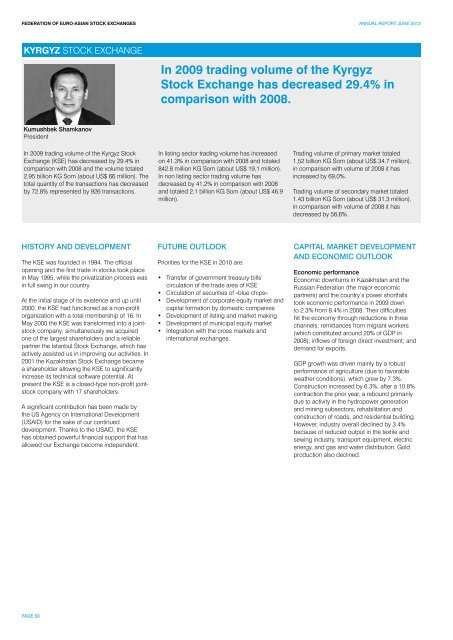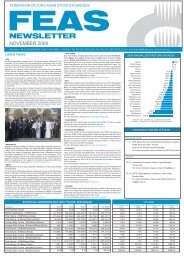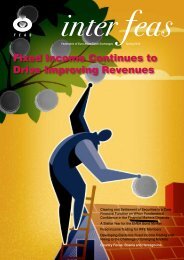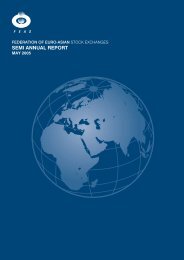JUNE 2013 - FEAS
JUNE 2013 - FEAS
JUNE 2013 - FEAS
Create successful ePaper yourself
Turn your PDF publications into a flip-book with our unique Google optimized e-Paper software.
FEDERATION OF EURO-ASIAN STOCK EXCHANGES ANNUAL REPORT <strong>JUNE</strong> <strong>2013</strong><br />
KYRGYZ STOCK EXCHANGE<br />
In 2009 trading volume of the Kyrgyz<br />
Stock Exchange has decreased 29.4% in<br />
comparison with 2008.<br />
Kumushbek Shamkanov<br />
President<br />
In 2009 trading volume of the Kyrgyz Stock<br />
Exchange (KSE) has decreased by 29.4% in<br />
comparison with 2008 and the volume totaled<br />
2,95 billion KG Som (about US$ 66 million). The<br />
total quantity of the transactions has decreased<br />
by 72.8% represented by 926 transactions.<br />
In listing sector trading volume has increased<br />
on 41.3% in comparison with 2008 and totaled<br />
842.8 million KG Som (about US$ 19,1 million).<br />
In non listing sector trading volume has<br />
decreased by 41,2% in comparison with 2008<br />
and totaled 2,1 billion KG Som (about US$ 46.9<br />
million).<br />
Trading volume of primary market totaled<br />
1,52 billion KG Som (about US$ 34,7 million),<br />
in comparison with volume of 2008 it has<br />
increased by 69,0%.<br />
Trading volume of secondary market totaled<br />
1.43 billion KG Som (about US$ 31,3 million),<br />
in comparison with volume of 2008 it has<br />
decreased by 56,6%.<br />
HISTORY AND DEVELOPMENT<br />
The KSE was founded in 1994. The official<br />
opening and the first trade in stocks took place<br />
in May 1995, while the privatization process was<br />
in full swing in our country.<br />
At the initial stage of its existence and up until<br />
2000, the KSE had functioned as a non-profit<br />
organization with a total membership of 16. In<br />
May 2000 the KSE was transformed into a jointstock<br />
company; simultaneously we acquired<br />
one of the largest shareholders and a reliable<br />
partner the Istanbul Stock Exchange, which has<br />
actively assisted us in improving our activities. In<br />
2001 the Kazakhstan Stock Exchange became<br />
a shareholder allowing the KSE to significantly<br />
increase its technical software potential. At<br />
present the KSE is a closed-type non-profit jointstock<br />
company with 17 shareholders.<br />
A significant contribution has been made by<br />
the US Agency on International Development<br />
(USAID) for the sake of our continued<br />
development. Thanks to the USAID, the KSE<br />
has obtained powerful financial support that has<br />
allowed our Exchange become independent.<br />
FUTURE OUTLOOK<br />
Priorities for the KSE in 2010 are:<br />
• Transfer of government treasury bills’<br />
circulation of the trade area of KSE<br />
• Circulation of securities of «blue chips»<br />
• Development of corporate equity market and<br />
capital formation by domestic companies<br />
• Development of listing and market making<br />
• Development of municipal equity market<br />
• Integration with the cross markets and<br />
international exchanges.<br />
CAPITAL MARKET DEVELOPMENT<br />
AND ECONOMIC OUTLOOK<br />
Economic performance<br />
Economic downturns in Kazakhstan and the<br />
Russian Federation (the major economic<br />
partners) and the country’s power shortfalls<br />
took economic performance in 2009 down<br />
to 2.3% from 8.4% in 2008. Their difficulties<br />
hit the economy through reductions in three<br />
channels: remittances from migrant workers<br />
(which constituted around 20% of GDP in<br />
2008); inflows of foreign direct investment; and<br />
demand for exports.<br />
GDP growth was driven mainly by a robust<br />
performance of agriculture (due to favorable<br />
weather conditions), which grew by 7.3%.<br />
Construction increased by 6.3%, after a 10.8%<br />
contraction the prior year, a rebound primarily<br />
due to activity in the hydropower generation<br />
and mining subsectors, rehabilitation and<br />
construction of roads, and residential building.<br />
However, industry overall declined by 3.4%<br />
because of reduced output in the textile and<br />
sewing industry, transport equipment, electric<br />
energy, and gas and water distribution. Gold<br />
production also declined.<br />
PAGE 58
















